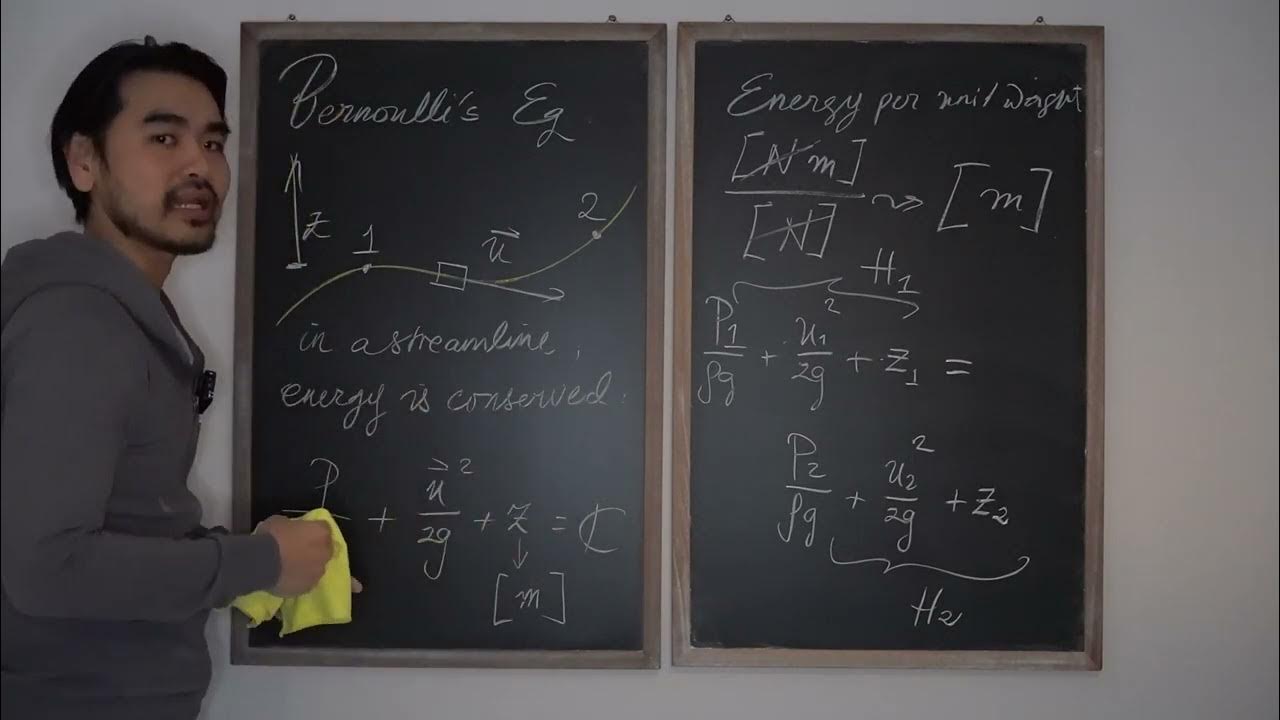Mekanika Fluida FM01 (Lecture3: 2/8). Menurunkan Persamaan Bernoulli
Summary
TLDRIn this video, the presenter walks viewers through the derivation of Bernoulli's equation from a mathematical perspective, rather than just through the concept of energy conservation. The process involves analyzing forces within a streamline coordinate system, using calculus and breaking down forces such as pressure, gravity, and acceleration. The explanation emphasizes simplifying complex equations by considering small fluid parcels and their behavior within a streamline. By applying fundamental principles, the presenter demonstrates the relationship between fluid pressure, velocity, and elevation, ultimately leading to the complete derivation of Bernoulli's equation.
Takeaways
- 😀 The Bernoulli equation can be derived not only from energy conservation but also using calculus, providing a deeper understanding of its origins.
- 😀 The concept of streamline is introduced as a key idea for analyzing forces acting on a fluid parcel in motion.
- 😀 The speaker emphasizes the importance of using different coordinate systems, such as streamline coordinates, instead of Cartesian coordinates for this derivation.
- 😀 The forces acting on the fluid parcel are analyzed step by step, including pressure forces, weight (gravitational forces), and the change in momentum.
- 😀 The pressure difference along the streamline is simplified using first-order Taylor expansion.
- 😀 The breakdown of forces also includes an analysis of the weight component and its projection onto the streamline axis.
- 😀 A simplification step is made by manipulating the mass and volume relationships to eliminate unnecessary terms and constants.
- 😀 The incompressibility assumption is applied, which allows for simplifying the mathematical terms and extracting constants from integrals.
- 😀 The Bernoulli equation is derived through integration, leading to the final expression of pressure, velocity, and gravitational potential energy as a constant along a streamline.
- 😀 The speaker demonstrates how Bernoulli's equation can also be written in different forms, such as the form that includes specific units of energy per unit mass.
- 😀 The derivation of Bernoulli's equation from first principles, particularly from the forces acting on a fluid parcel, helps in understanding its application to engineering problems in real life.
Q & A
What is the primary purpose of deriving Bernoulli's equation in the script?
-The primary purpose is to understand Bernoulli's equation not just from an energy conservation perspective, but through a mathematical derivation using concepts from calculus and Newton's second law.
What is a streamline, as described in the script?
-A streamline is a path traced by a fluid element in motion, showing the trajectory of particles within the fluid as they move along with the flow. It's essentially the line formed by the positions of fluid particles in steady flow.
Why is the coordinate system changed from Cartesian coordinates to streamline coordinates?
-The coordinate system is changed to streamline coordinates because the analysis focuses on forces acting along the streamline, and this makes it easier to describe the forces and motion in the context of fluid flow.
What assumptions are made in the derivation of Bernoulli's equation?
-The key assumptions include considering the fluid as incompressible and the flow as steady, and also analyzing small parcels of fluid within the streamline. The derivation also assumes that the forces acting are pressure, gravity, and the changes in velocity.
How are the forces on a small fluid parcel analyzed in the script?
-The forces acting on a small fluid parcel are analyzed by breaking them down into components, including pressure forces (acting normal to the surface) and gravitational forces (acting vertically). These forces are then manipulated using calculus and simplified to lead to the Bernoulli equation.
How does the script use Taylor expansion in the derivation?
-The script uses first-order Taylor expansion to express the pressure variation in terms of a differential, allowing the relationship between pressure changes over a small distance to be approximated, helping to simplify the derivation of the Bernoulli equation.
What is the role of the velocity vector in the derivation?
-The velocity vector represents the speed and direction of the fluid particles. In the derivation, the velocity is crucial in determining the kinetic energy of the fluid and how the pressure changes as the fluid moves along the streamline.
Why is the density of the fluid treated as constant in the derivation?
-The density is assumed to be constant because the fluid is considered incompressible, meaning that its density does not change as it moves through the streamline, simplifying the analysis and making it easier to apply Bernoulli's equation.
What is the final form of Bernoulli's equation as presented in the script?
-The final form of Bernoulli's equation presented in the script is: P/ρ + (v^2/2) + gz = constant, where P is the pressure, ρ is the density, v is the velocity, g is the gravitational acceleration, and z is the height.
How does the script emphasize the practical application of Bernoulli's equation?
-The script emphasizes that understanding the derivation of Bernoulli's equation, especially from a force perspective, is essential for applying it to real-world engineering problems, rather than just memorizing it as a conservation of energy principle.
Outlines

This section is available to paid users only. Please upgrade to access this part.
Upgrade NowMindmap

This section is available to paid users only. Please upgrade to access this part.
Upgrade NowKeywords

This section is available to paid users only. Please upgrade to access this part.
Upgrade NowHighlights

This section is available to paid users only. Please upgrade to access this part.
Upgrade NowTranscripts

This section is available to paid users only. Please upgrade to access this part.
Upgrade NowBrowse More Related Video

MekFlu #2: Persamaan Bernoulli, Kontinuitas dan Kekekalan Energi

Bernoulli's Principle Derivation

Mekanika Fluida FM01 (Lecture3: 8/8). Energy Line & Hydraulic Grade Line

Mekanika Fluida FM01 (Lecture3: 1/8). Persamaan Bernoulli (Pengenalan)

Bernoulli's Equation for Fluid Flow Video in Physics

FISIKA KELAS XI - HUKUM BERNOULLI || FLUIDA DINAMIS
5.0 / 5 (0 votes)